Corrosion Resistance of Modified Hexagonal Boron Nitride (h-BN) Nanosheets Doped Acrylic Acid Coating on Hot-Dip Galvanized Steel
Abstract
1. Introduction
2. Experimental
2.1. Materials
2.2. Stripping of BNNS
2.3. Preparation of Modified BNNS (560/BNNS)
2.4. Preparation of Anticorrosive Coatings
2.5. Characterisation Method
2.5.1. Morphological and Structural Characterisations of BNNS and 560/BNNS
2.5.2. Characterisation of Corrosion Resistance
3. Results and Discussion
3.1. Morphology and Composition of BNNSs and 560/BNNS
3.2. Microstructure and Morphology of Anticorrosive Coatings
3.3. Electrochemical Studies
3.4. Mechanism of Corrosion Resistance Enhancement
4. Conclusions
Author Contributions
Funding
Conflicts of Interest
References
- Söylev, T.; Richardson, M. Corrosion inhibitors for steel in concrete: State-of-the-art report. Constr. Build. Mater. 2008, 22, 609–622. [Google Scholar] [CrossRef]
- Wang, J.; Wang, K.; Zhang, T.; Wang, S. Key aspects of a DN4000 steel pipe jacking project in China: A case study of a water pipeline in the Shanghai Huangpu River. Tunn. Undergr. Space Technol. 2018, 72, 323–332. [Google Scholar] [CrossRef]
- Meinert, K.C.; Uerpmann, J.; Matschullat, G.K. Wolf Corrosion and leaching of silver doped ceramic IBAD coatings on SS 316L under simulated physiological conditions. Surf. Coat. Technol. 1998, 103, 58–65. [Google Scholar] [CrossRef]
- Bierwagen, G.P. Reflections on corrosion control by organic coatings. Prog. Org. Coat. 1996, 28, 43–48. [Google Scholar] [CrossRef]
- Khan, M.H.; Liu, H.-K.; Sun, X.; Yamauchi, Y.; Bando, Y.; Golberg, D.; Huang, Z. Few-atomic-layered hexagonal boron nitride: CVD growth, characterization, and applications. Mater. Today 2017, 20, 611–628. [Google Scholar] [CrossRef]
- Li, X.; Wang, G.; Li, X. Surface modifification of nano-SiO2 particles using polyaniline. Surf. Coat. Technol. 2005, 197, 56–60. [Google Scholar] [CrossRef]
- Xu, C.; Jin, W.; Wang, H.; Wu, H.; Huang, N.; Li, Z.; Mao, J. Organic corrosion inhibitor of triethylenetetramine into chloride contamination concrete by eletro-injection method. Constr. Build. Mater. 2016, 115, 602–617. [Google Scholar] [CrossRef]
- Ma, Z.-S.; Ding, H.-L.; Liu, Z.; Cheng, Z.-L. Preparation and tribological properties of hydrothermally exfoliated ultrathin hexagonal boron nitride nanosheets (BNNSs) in mixed NaOH/KOH solution. J. Alloys Compd. 2019, 784, 807–815. [Google Scholar] [CrossRef]
- Sun, W.; Wang, L.; Wu, T.; Pan, Y.; Liu, G. Synthesis of low-electrical-conductivity graphene/pernigraniline composites and their application in corrosion protection. Carbon 2014, 79, 605–614. [Google Scholar] [CrossRef]
- Liang, M.; Wu, J.; Fang, D.; Li, B.; Yang, Y. Corrosion protection of waterborne epoxy containing mussel-inspired adhesive polymers based on polyaspartamide derivatives on carbon steel. J. Mater. Sci. Technol. 2018, (in press). [CrossRef]
- Ai, D.; Mo, R.; Wang, H.; Lai, Y.; Jiang, X.; Zhang, X. Preparation of waterborne epoxy dispersion and its application in 2K waterborne epoxy coatings. Prog. Org. Coat. 2019, 136. [Google Scholar] [CrossRef]
- Wang, M.; Wang, J.; Hu, W. Preparation and corrosion behavior of Cu-8-HQ@HNTs/epoxy coating. Prog. Org. Coat. 2020, 139, 105434. [Google Scholar] [CrossRef]
- Ma, L.; Chen, F.F.; Li, Z.T.; Gan, M.Y.; Yan, J. Preparation and anticorrosion property of poly modifified by nano-SiO2. Compos. Part B 2014, 58, 54–58. [Google Scholar] [CrossRef]
- Figueira, R.B.; Sousa, R.; Silva, C.J. Chapter 3-Multifuntional and smart organic-inorganic hybrid sol-gel coatings for corrosion protection application. In Advances in Smart Coatings and Thin Films for Future Industrial and Biomedical Engineering Applications; Elsevier: Amsterdam, The Netherlands, 2018; pp. 57–97. [Google Scholar]
- Khun, N.W.; Liu, E.; Zeng, X.T. Corrosion behavior of nitrogen doped diamond-like carbon thin fifilms in NaCl solutions. Corros. Sci. 2009, 51, 2158–2164. [Google Scholar] [CrossRef]
- Choudhury, N.R.; Kannan, A.G.; Dutta, N.K. Chapter 21—Novel nanocomposites and hybrids for lubricating coating applications. Tribol. Interface Eng. Ser. 2005, 55, 501–542. [Google Scholar]
- Izadi, M.; Shahrabi, T.; Ramezanzadeh, B. Active corrosion protection performance of an epoxy coating applied on the mild steel modified with an eco-friendly sol-gel film impregnated with green corrosion inhibitor loaded nanocontainers. Appl. Surf. Sci. 2018, 440, 491–505. [Google Scholar] [CrossRef]
- Matin, E.; Attar, M.; Ramezanzadeh, B. Investigation of corrosion protection properties of an epoxy nanocomposite loaded with polysiloxane surface modified nanosilica particles on the steel substrate. Prog. Org. Coat. 2015, 78, 395–403. [Google Scholar] [CrossRef]
- Abbas, S.; Abbas, A.; Liu, Z.; Tang, C. The two-dimensional boron nitride hierarchical nanostructures: Controllable synthesis and superhydrophobicity. Mater. Chem. Phys. 2020, 240, 122145. [Google Scholar] [CrossRef]
- Chruściel, J.J.; Leśniak, E. Modification of epoxy resins with functional silanes, polysiloxanes, silsesquioxanes, silica and silicates. Prog. Polym. Sci. 2015, 41, 67–121. [Google Scholar] [CrossRef]
- Safarpour, M.; Arefifi-Oskoui, S.; Khataee, A. A review on two-dimensional metal oxide and metal hydroxide nanosheets for modifification of polymeric membranes. J. Ind. Eng. Chem. 2018, 10, 154–161. [Google Scholar]
- Yu, Z.; Di, H.; Ma, Y.; Lv, L.; Pan, Y.; Zhang, C.; He, Y. Fabrication of graphene oxide–alumina hybrids to reinforce the anti-corrosion performance of composite epoxy coatings. Appl. Surf. Sci. 2015, 351, 986–996. [Google Scholar] [CrossRef]
- Zhou, S.; Wu, Y.; Zhao, W.; Yu, J.; Jiang, F.; Ma, L. Comparative corrosion resistance of graphene sheets with different structures in waterborne epoxy coatings. Colloids Surf. A Physicochem. Eng. Asp. 2018, 556, 273–283. [Google Scholar] [CrossRef]
- Zhang, Q.; Xu, Y.-H.; Wen, Z.-G. Influence of water-borne epoxy resin content on performance of waterborne epoxy resin compound SBR modified emulsified asphalt for tack coat. Constr. Build. Mater. 2017, 153, 774–782. [Google Scholar] [CrossRef]
- Ding, J.; Rahman, O.U.; Peng, W.; Dou, H.; Yu, H. A novel hydroxyl epoxy phosphate monomer enhancing the anticorrosive performance of waterborne Graphene/Epoxy coatings. Appl. Surf. Sci. 2018, 427, 981–991. [Google Scholar] [CrossRef]
- Su, C. Environmental implications and applications of engineered nanoscale magnetite and its hybrid nanocomposites: A review of recent literature. J. Hazard. Mater. 2017, 322, 48–84. [Google Scholar] [CrossRef] [PubMed]
- Yun, T.H.; Park, J.H.; Kim, J.-S.; Park, J.M. Effect of the surface modification of zinc powders with organosilanes on the corrosion resistance of a zinc pigmented organic coating. Prog. Org. Coat. 2014, 77, 1780–1788. [Google Scholar] [CrossRef]
- Wu, P.-R.; Kong, Y.-C.; Ma, Z.-S.; Ge, T.; Feng, Y.-M.; Liu, Z.; Cheng, Z.-L. Preparation and tribological properties of novel zinc borate/MoS2 nanocomposites in grease. J. Alloys Compd. 2018, 740, 823–829. [Google Scholar] [CrossRef]
- Wang, H.; Zhang, S.; Li, Y.; Wang, W.; Wang, H.; Fu, Z. Defect-induced formation mechanism for boron nitride nanosheets-nanotubes hybrid structures. Scr. Mater. 2019, 171, 16–20. [Google Scholar] [CrossRef]
- Tian, J.; Wu, S.; Yin, X.; Wu, W. Novel preparation of hydrophilic graphene/graphene oxide nanosheets for supercapacitor electrode. Appl. Surf. Sci. 2019, 496. [Google Scholar] [CrossRef]
- Farmanzadeh, D.; Ardehjani, N.A.; Askari, N. Theoretical study of ozone adsorption on the surface of Fe, Co and Ni doped boron nitride nanosheets. Appl. Surf. Sci. 2018, 444, 642–649. [Google Scholar] [CrossRef]
- Kar, P. Chapter 8—Anticorrosion and antiwear. Nanomater. Based Coat. 2019, 195–236. [Google Scholar]
- Liu, S.; Chevali, V.; Xu, Z.; Hui, D.; Wang, H. A review of extending performance of epoxy resins using carbon nanomaterials. Compos. Part B Eng. 2018, 136, 197–214. [Google Scholar] [CrossRef]
- Olajire, A.A. Recent advances on organic coating system technologies for corrosion protection of offshore metallic structures. J. Mol. Liq. 2018, 269, 572–606. [Google Scholar] [CrossRef]
- Arukalam, I.O.; Oguzie, E.E.; Li, Y. Nanostructured superhydrophobic polysiloxane coating for high barrier and anticorrosion applications in marine environment. J. Colloid Interface Sci. 2018, 512, 674–685. [Google Scholar] [CrossRef] [PubMed]
- Tan, B.; Thomas, N. A review of the water barrier properties of polymer/clay and polymer/graphene nanocomposites. J. Membr. Sci. 2016, 514, 595–612. [Google Scholar] [CrossRef]
- Bonora, P.; Deflorian, F.; Fedrizzi, L. Electrochemical impedance spectroscopy as a tool for investigating underpaint corrosion. Electrochim. Acta 1996, 41, 1073–1082. [Google Scholar] [CrossRef]
- Chen, Y.; Wang, X.; Luo, S.; Bao, Y. Synthesis of new Tb-doped Zn-Al LDH/tryptophan hybrids and their fluorescent property. J. Rare Earths 2016, 34, 1095–1102. [Google Scholar] [CrossRef]
- Wu, X. Theoretical investigation of the effect of hexagonal boron nitride on perfect absorption in infrared regime. Opt. Commun. 2018, 425, 172–175. [Google Scholar] [CrossRef]
- De Assis, S.L.; Wolynec, S.; Costa, I. Corrosion characterization of titanium alloys by electrochemical techniques. Electrochim. Acta 2006, 51, 1815–1819. [Google Scholar] [CrossRef]
- Hu, P.; Song, R.; Li, X.-J.; Deng, J.; Chen, Z.-Y.; Li, Q.-W.; Wang, K.-S.; Cao, W.-C.; Liu, D.-X.; Yu, H. Influence of concentrations of chloride ions on electrochemical corrosion behavior of titanium-zirconium-molybdenum alloy. J. Alloys Compd. 2017, 708, 367–372. [Google Scholar] [CrossRef]
- Morończyk, B.; Ura-Bińczyk, E.; Kuroda, S.; Jaroszewicz, J.; Molak, R. Microstructure and corrosion resistance of warm sprayed titanium coatings with polymer sealing for corrosion protection of AZ91E magnesium alloy. Surf. Coat. Technol. 2019, 363, 142–151. [Google Scholar] [CrossRef]
- Liu, Q.; Ma, R.; Du, A.; Zhang, X. Investigation of the anticorrosion properties of graphene oxide doped thin organic anticorrosion fifilms for hot-dip galvanized steel. Appl. Surf. Sci. 2019, 480, 646–654. [Google Scholar] [CrossRef]
- Baptista, R.; Mendão, A.; Rodrigues, F.; Figueiredo-Pina, C.; Guedes, M.; Marat-Mendes, R. Effect of high graphite filler contents on the mechanical and tribological failure behavior of epoxy matrix composites. Theor. Appl. Fract. Mech. 2016, 85, 113–124. [Google Scholar] [CrossRef]
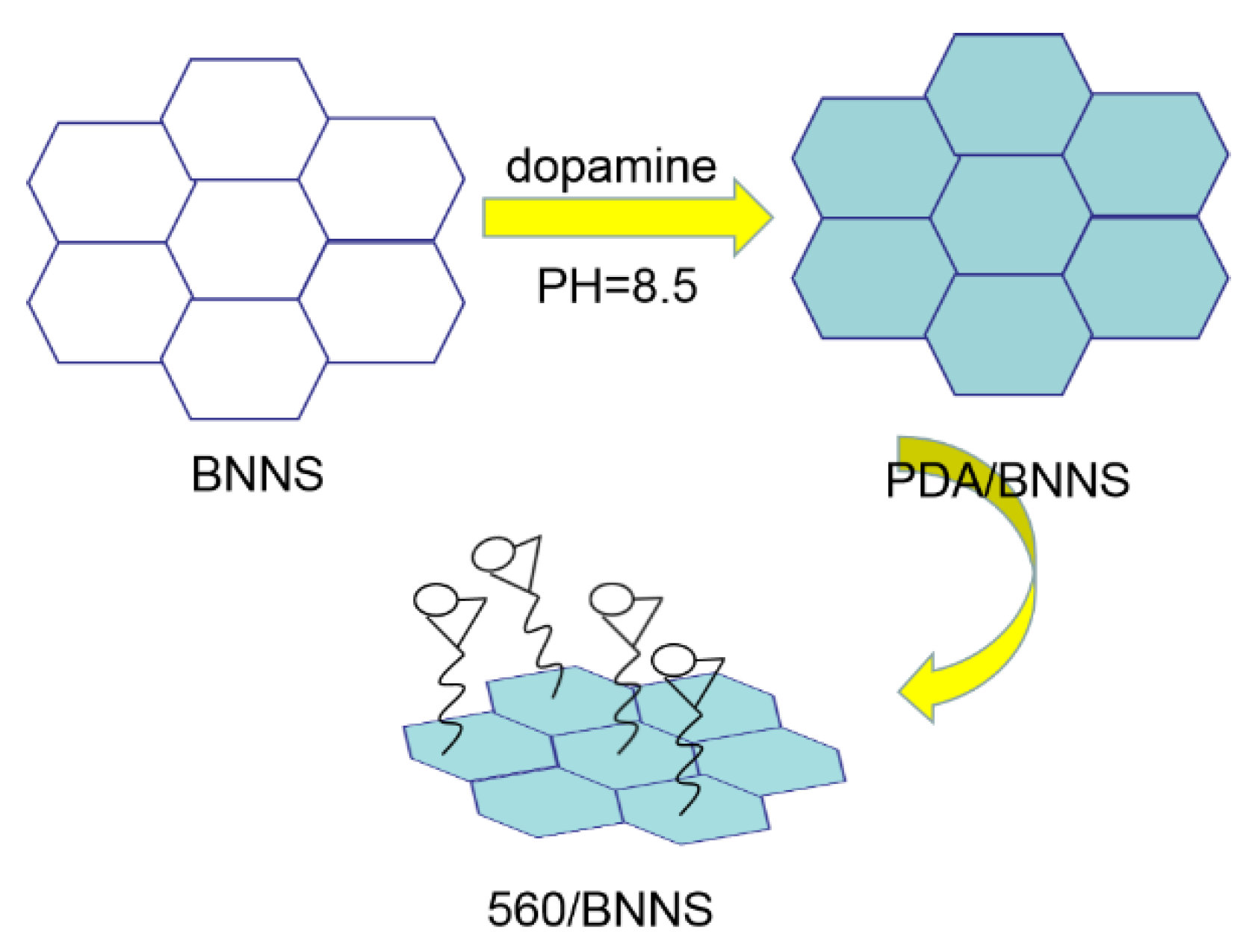
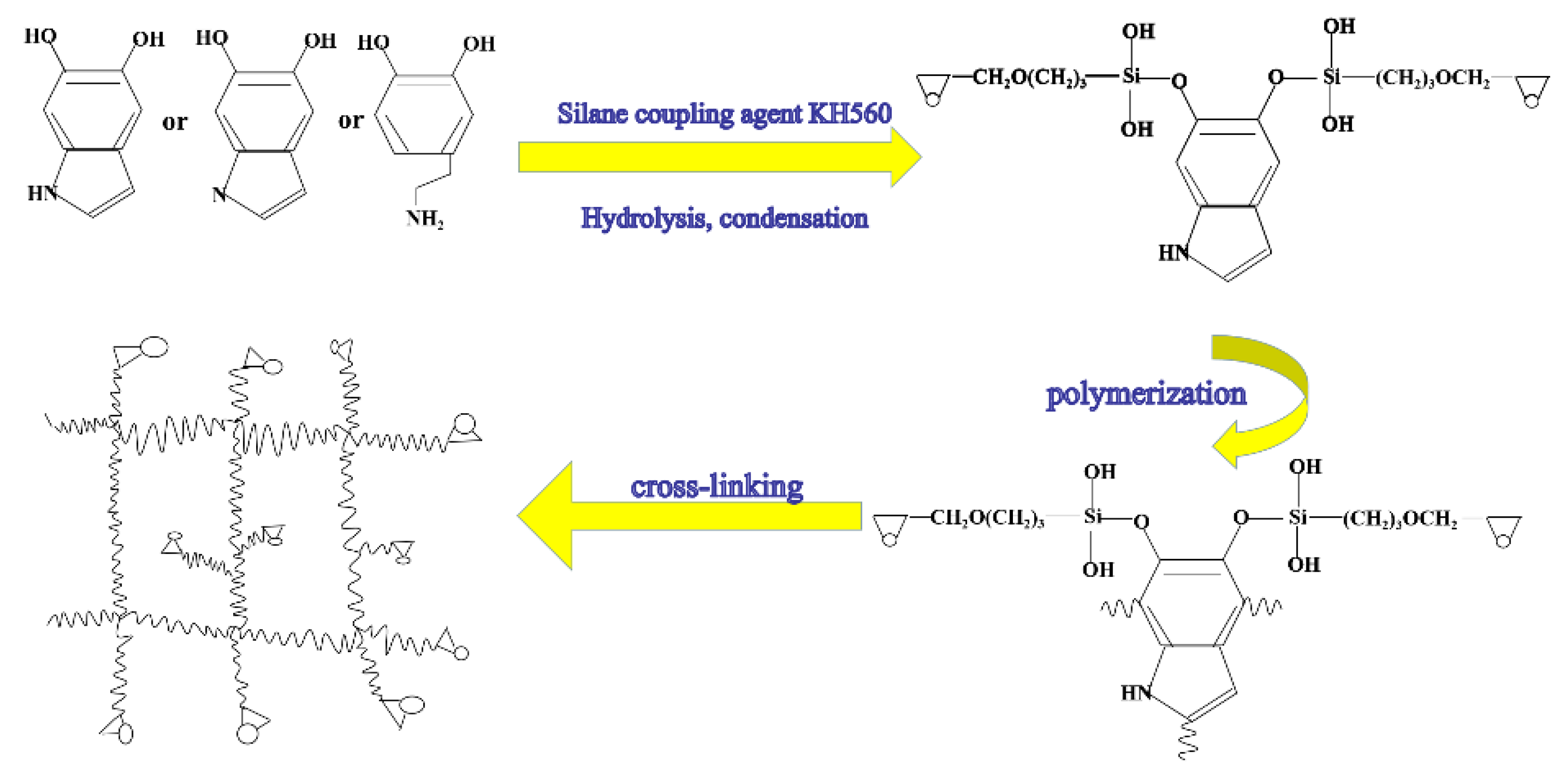
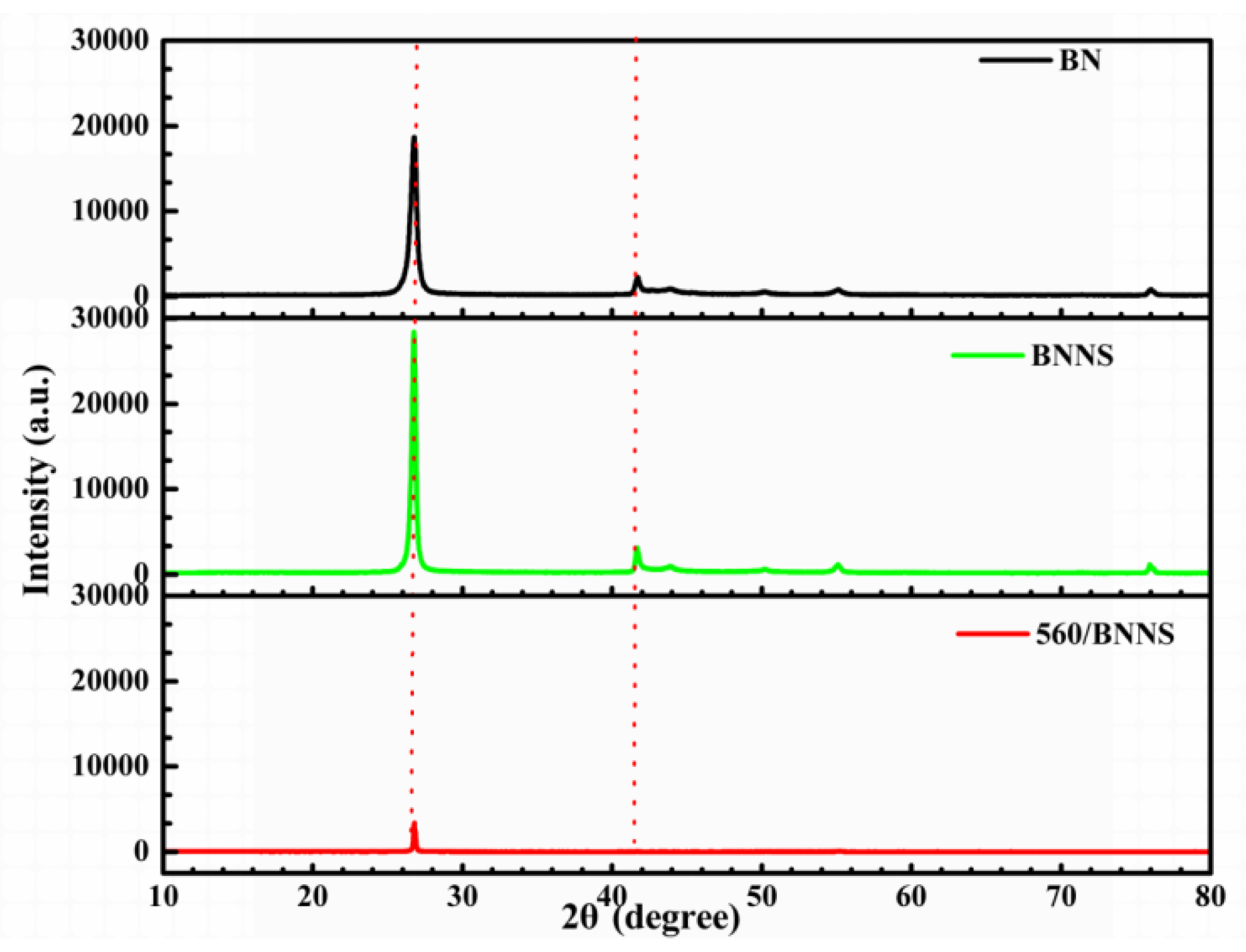
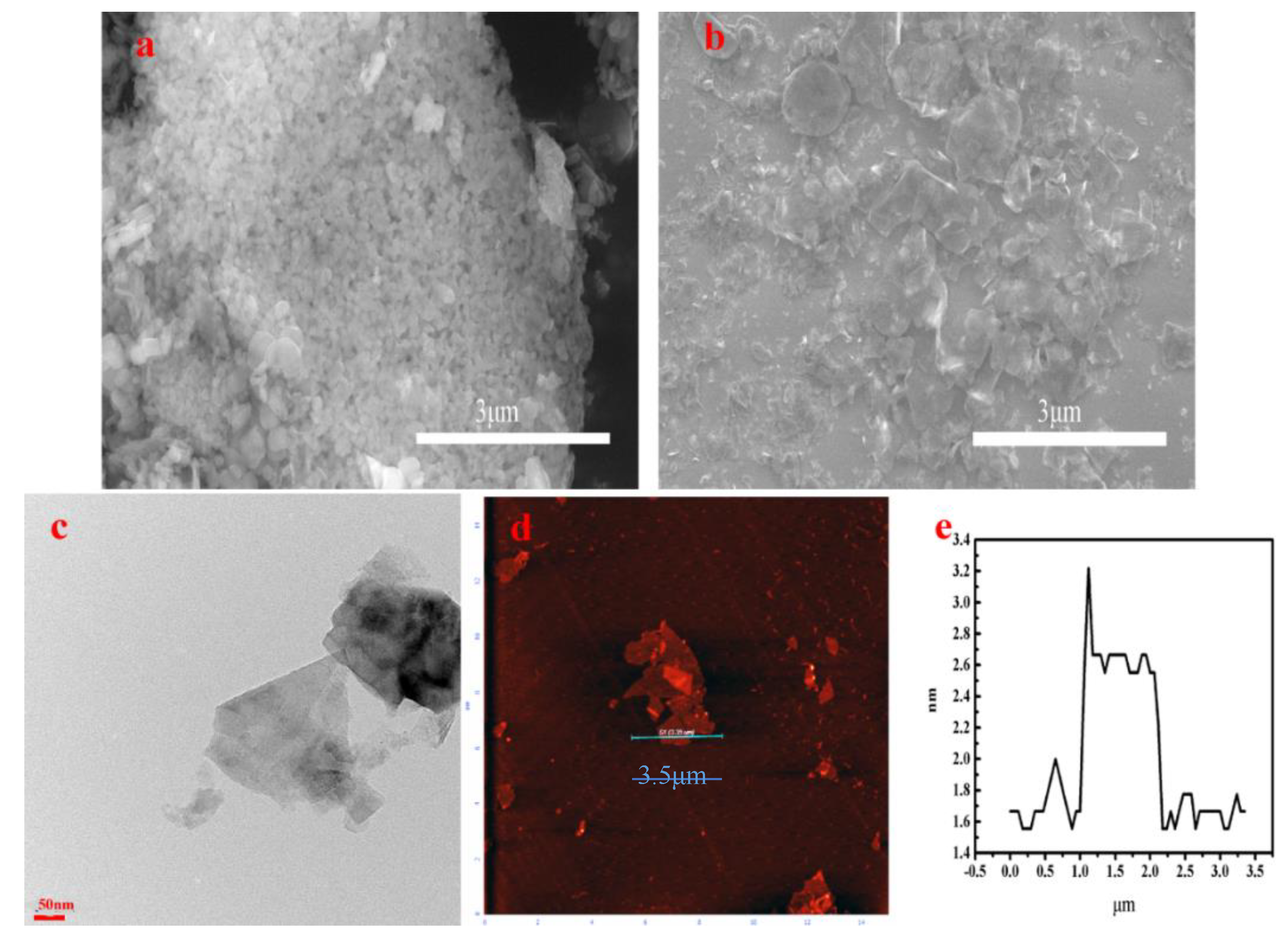
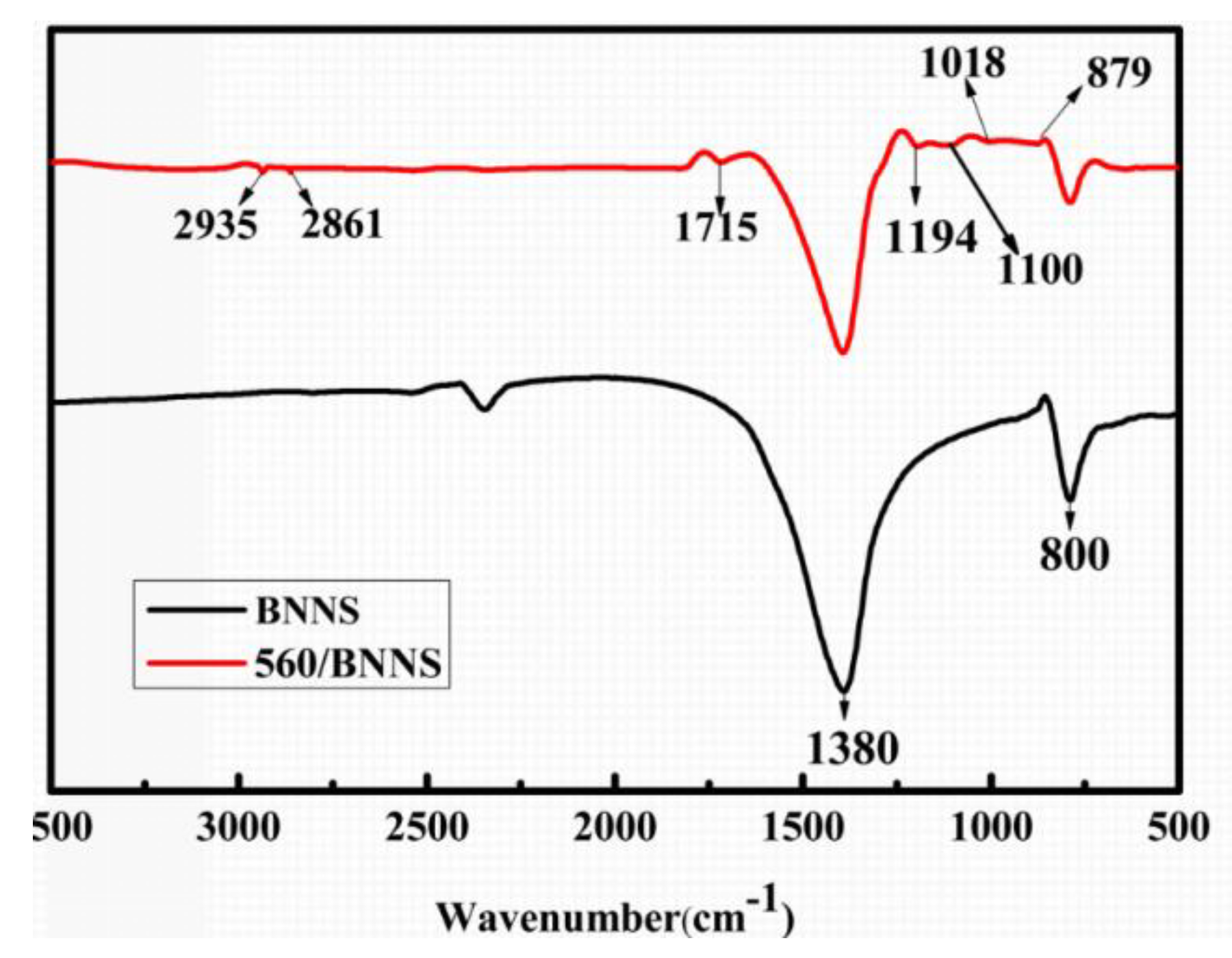
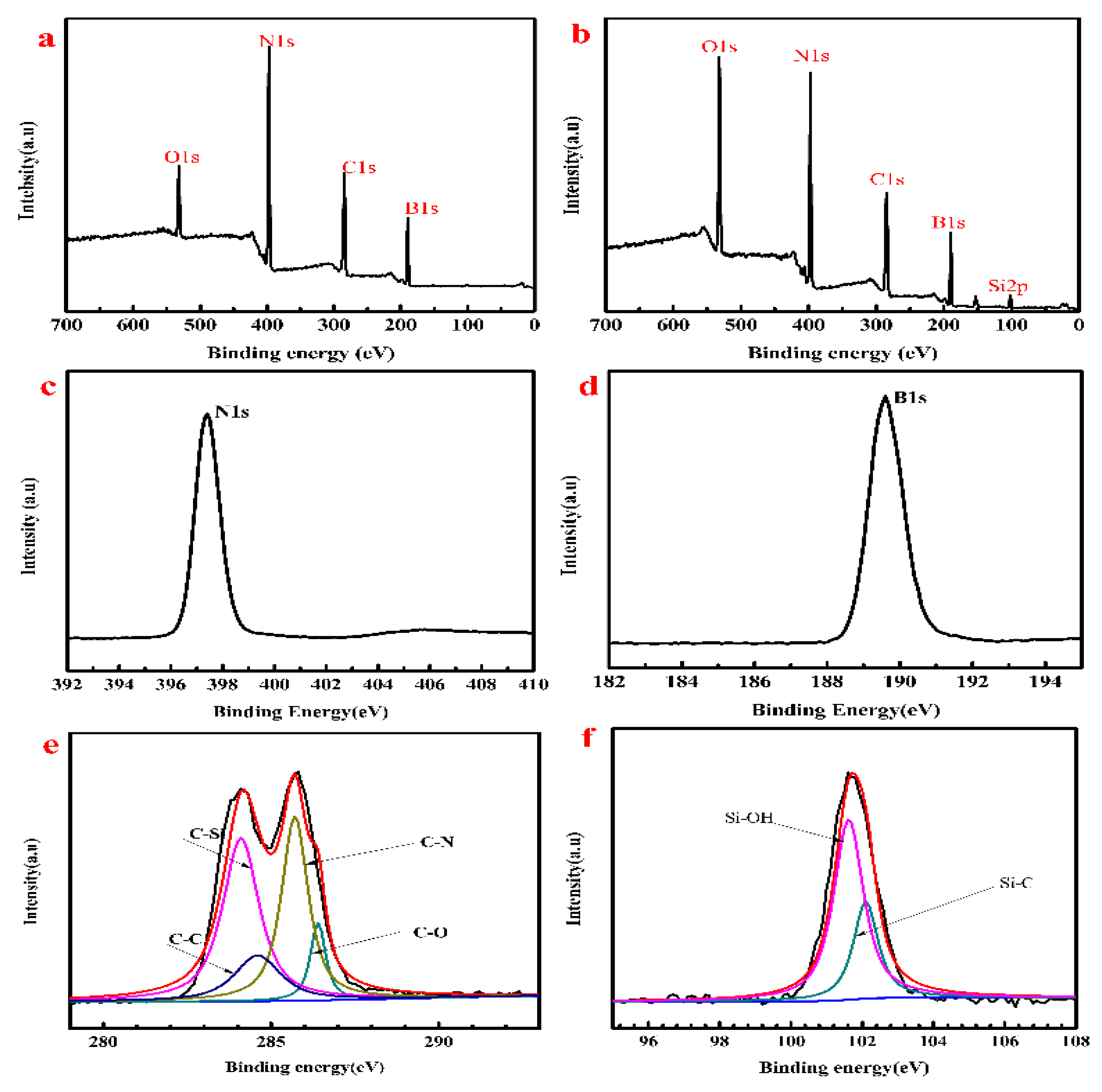
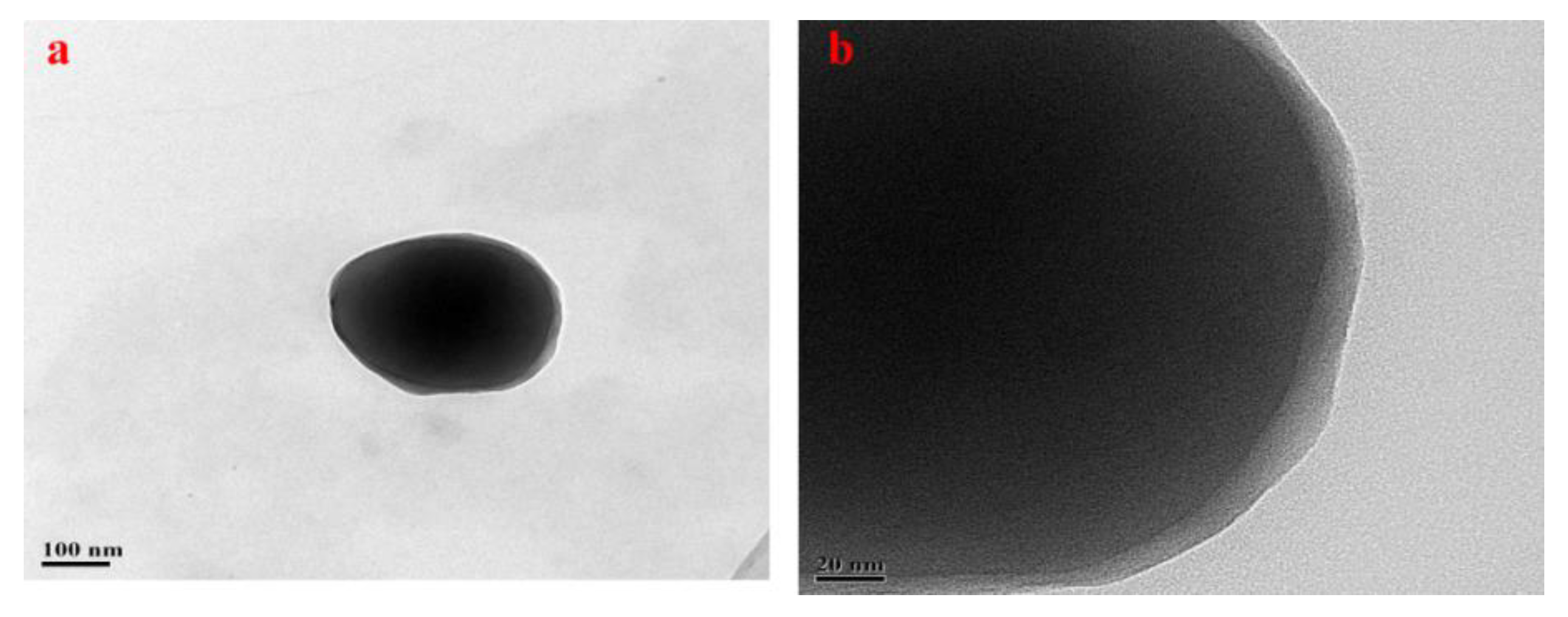
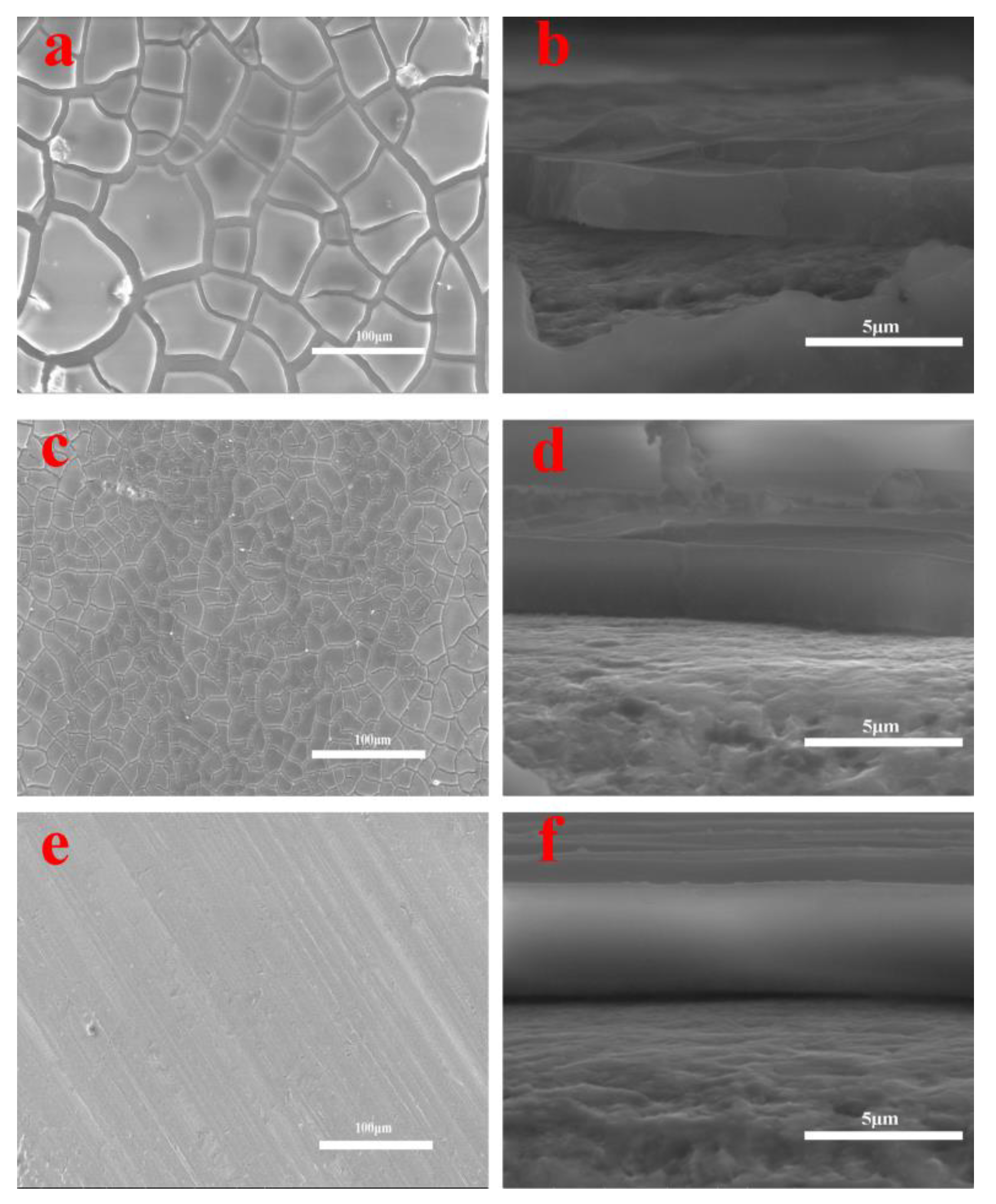
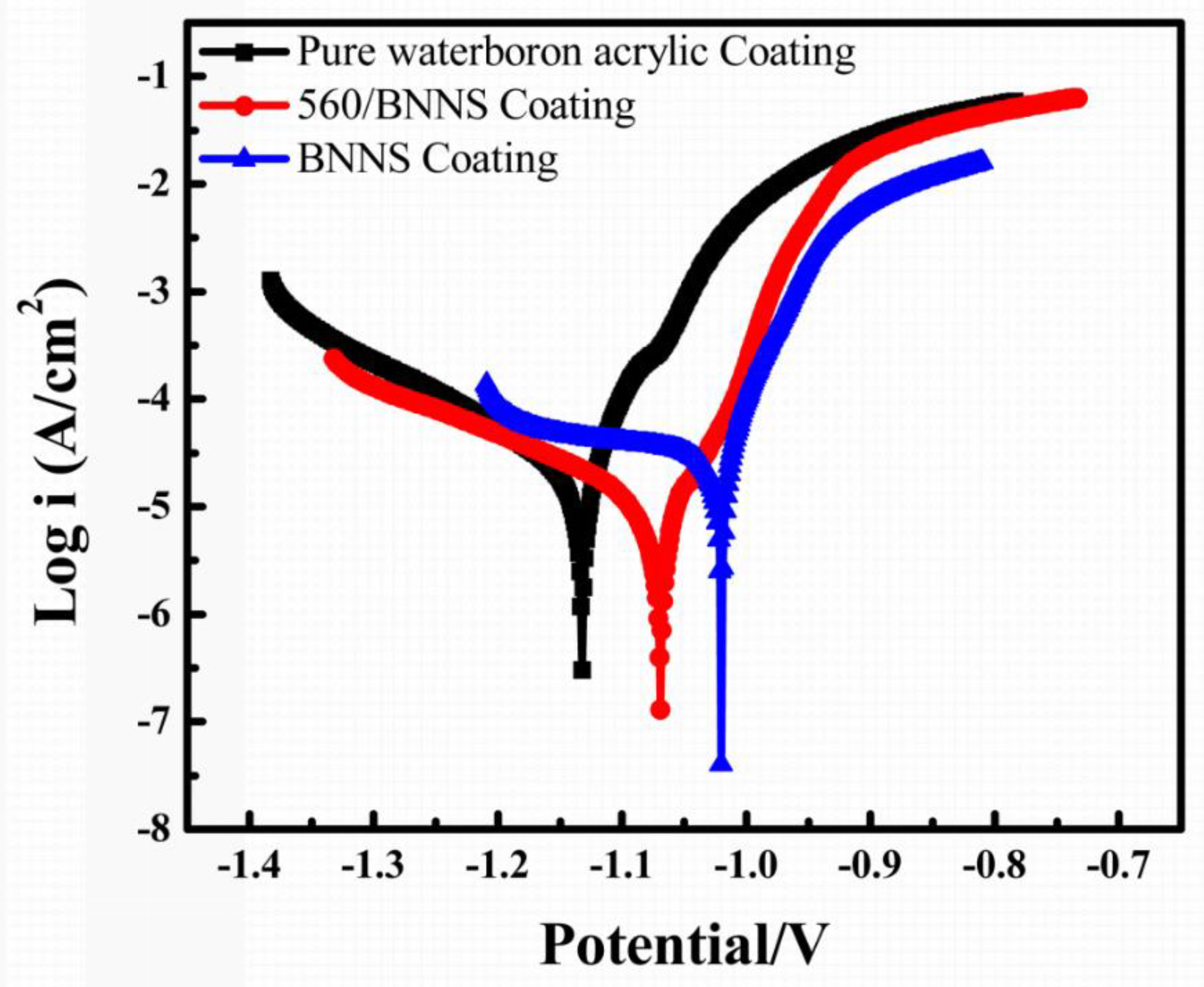
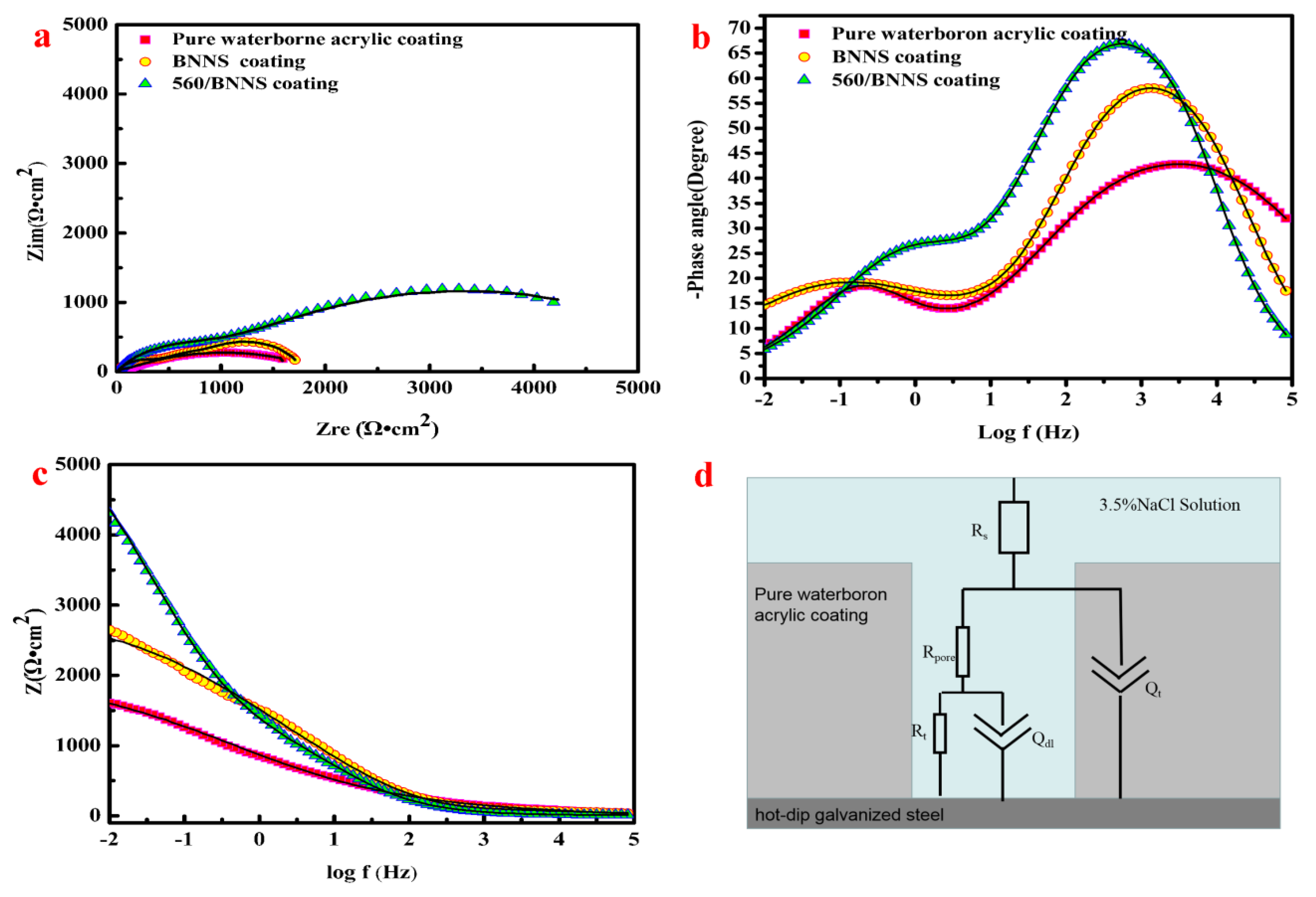
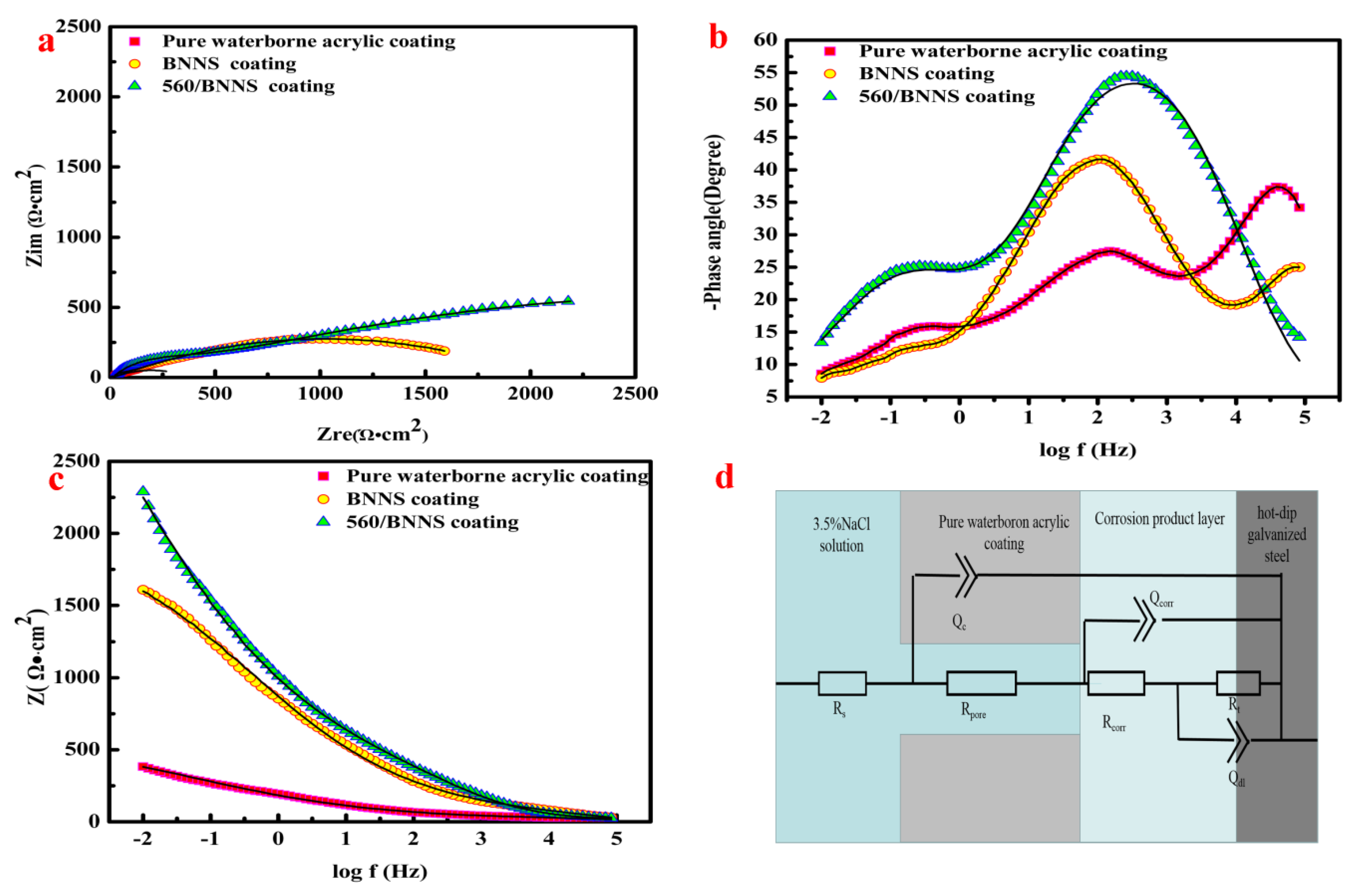
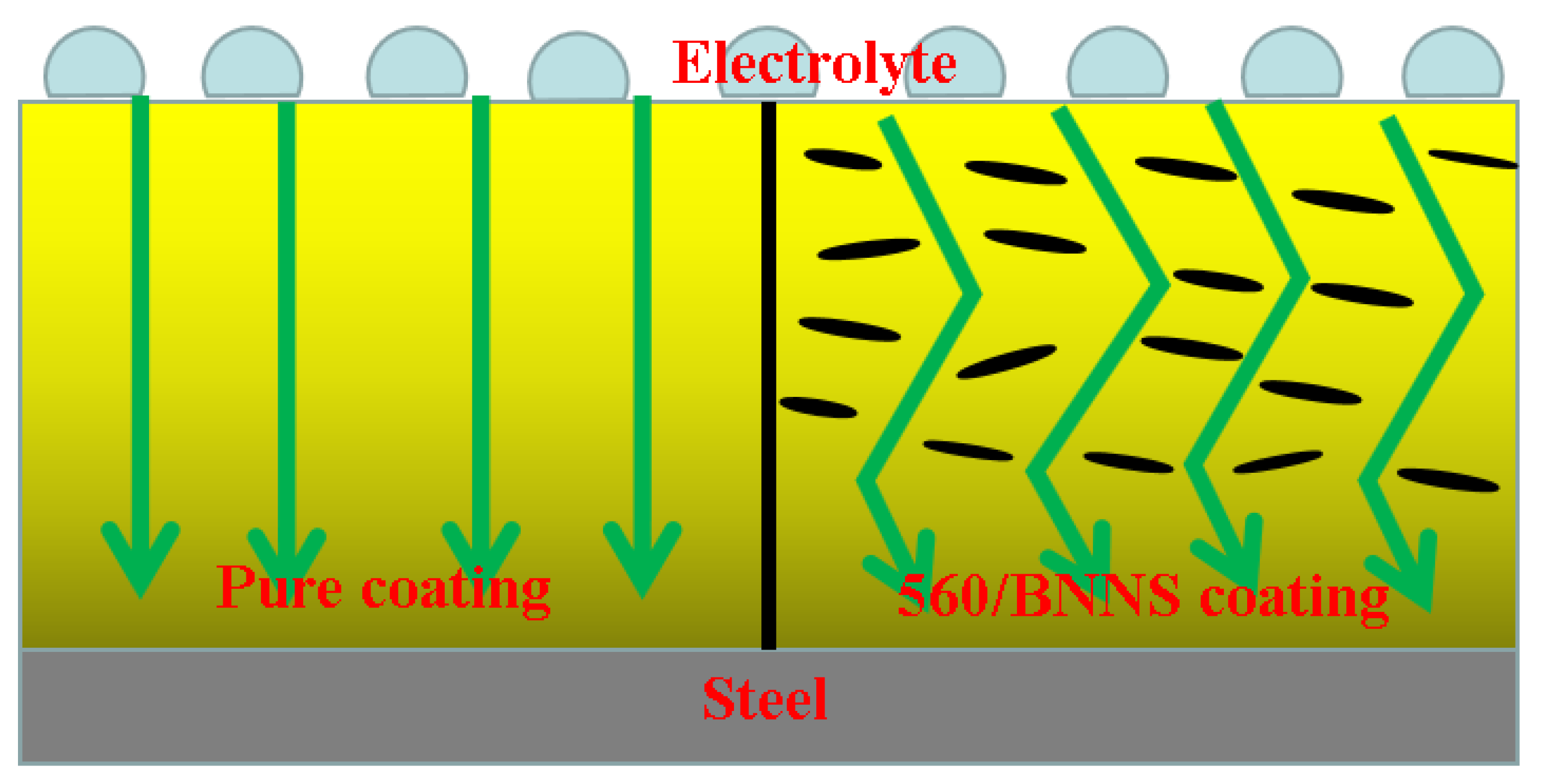
| Sample | Icorr (A/cm2) | Ecorr (V) | Corrosion Rate (mm/year) |
|---|---|---|---|
| Pure waterboron acrylic Coating | 2.2 × 10−5 | −1.13 | 1.432 × 102 |
| BNNS Coating | 9.7 × 10−6 | −1.02 | 1.347 × 101 |
| 560/BNNS Coating | 2.3 × 10−7 | −1.06 | 3.734 × 100 |
| Sample | Pure Waterborne Acrylic Coating | BNNS Coating | 560/BNNS Coating |
|---|---|---|---|
| Rs (Ω·cm2) | 5.32 | 6.14 | 7.23 |
| Qc (Ω−1·cm−2·sn) | 1.32 × 10−4 | 5.37 × 10−5 | 1.44 × 10−6 |
| Rpores (Ω·cm−2) | 172 | 406 | 958 |
| Rt (Ω·cm−2) | 1500 | 2500 | 4435 |
| Qdl (Ω−1·cm−2·sn) | 6.52 × 10−3 | 2.65 × 10−3 | 5.84 × 10−4 |
| Sample | Pure Waterborne Acrylic Coating | BNNS Coating | 560/BNNS Coating |
|---|---|---|---|
| Rs (Ω·cm−2) | 3.97 | 5.23 | 5.46 |
| Qc (Ω−1·cm−2·sn) | 3.24 × 10−3 | 4.21 × 10−4 | 3.16 × 10−5 |
| Rpore (Ω·cm2) | 26.8 | 254.2 | 485.3 |
| Qdl (Ω−1·cm−2·sn) | 1.24 × 10−3 | 1.42 × 10−3 | 2.54 × 10−4 |
| Rt (Ω·cm−2) | 469 | 1538 | 2525 |
| Rcorr (Ω·cm−2) | 248.5 | 176.3 | 122.1 |
| Qcorr (Ω−1·cm−2·sn) | 5.87 × 10−3 | 4.57 × 10−3 | 5.74 × 10−3 |
© 2020 by the authors. Licensee MDPI, Basel, Switzerland. This article is an open access article distributed under the terms and conditions of the Creative Commons Attribution (CC BY) license (http://creativecommons.org/licenses/by/4.0/).
Share and Cite
Fan, Y.; Yang, H.; Fan, H.; Liu, Q.; Lv, C.; Zhao, X.; Yang, M.; Wu, J.; Cao, X. Corrosion Resistance of Modified Hexagonal Boron Nitride (h-BN) Nanosheets Doped Acrylic Acid Coating on Hot-Dip Galvanized Steel. Materials 2020, 13, 2340. https://doi.org/10.3390/ma13102340
Fan Y, Yang H, Fan H, Liu Q, Lv C, Zhao X, Yang M, Wu J, Cao X. Corrosion Resistance of Modified Hexagonal Boron Nitride (h-BN) Nanosheets Doped Acrylic Acid Coating on Hot-Dip Galvanized Steel. Materials. 2020; 13(10):2340. https://doi.org/10.3390/ma13102340
Chicago/Turabian StyleFan, Yongzhe, Huazhen Yang, Haisheng Fan, Qi Liu, Chuang Lv, Xue Zhao, Mingxu Yang, Jianjun Wu, and Xiaoming Cao. 2020. "Corrosion Resistance of Modified Hexagonal Boron Nitride (h-BN) Nanosheets Doped Acrylic Acid Coating on Hot-Dip Galvanized Steel" Materials 13, no. 10: 2340. https://doi.org/10.3390/ma13102340
APA StyleFan, Y., Yang, H., Fan, H., Liu, Q., Lv, C., Zhao, X., Yang, M., Wu, J., & Cao, X. (2020). Corrosion Resistance of Modified Hexagonal Boron Nitride (h-BN) Nanosheets Doped Acrylic Acid Coating on Hot-Dip Galvanized Steel. Materials, 13(10), 2340. https://doi.org/10.3390/ma13102340




